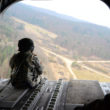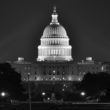ELIZABETH HOLTZMAN BEGINS HER dispassionate 2006 book, The Impeachment of George W. Bush, with an account of the House Judiciary Committee’s July 27, 1974, vote to impeach Richard Nixon. She describes her difficulty saying the word “yes” when it was time for her to cast her vote, and committee chairman Peter Rodino returning to his office to cry after the committee approved the articles of impeachment. The impeachment process the former Congresswoman describes had begun in earnest in February 1974, when the House approved a Resolution of Inquiry “to investigate fully and completely whether sufficient grounds exist for the House of Representatives to exercise its constitutional power to impeach Richard M. Nixon.”
As the thirty-third anniversary of Nixon’s August 9, 1974, resignation arrives, Holtzman’s book reads like an idea whose time has arrived. The justifications for impeaching George W. Bush, or at least beginning an impeachment inquiry, are evident. Some of them have become more apparent since the publication of Holtzman’s book (which was excerpted in these pages in the Nov. 15, 2006 issue). The Bush administration’s demonstrated contempt for the law, its disregard for the constitutional role of Congress, and the deceit involved in taking the country into war in Iraq make the case to at least begin the sort of inquiry the House undertook in 1974.
Impeachment implies great risk, but the nation is already in a constitutional crisis. The executive branch is openly defying the Congress—its constitutional co-equal—establishing precedents regarding the balance of power between the executive and legislative branches. In his most recent appearance before the Senate Judiciary Committee, Attorney General Alberto Gonzales refused to answer New York senator Charles Schumer’s question regarding who ordered Gonzales to go to the hospital room of then-Attorney General John Ashcroft three years ago to persuade the gravely ill Ashcroft to authorize an intelligence program that Ashcroft and his stand-in while he was ill had already refused to authorize.
Gonzales was Bush’s White House counsel at the time and was accompanied on that trip to the hospital by Andrew Card, who was then Bush’s chief of staff. Yet Gonzales wouldn’t give an answer regarding the late-night visit to George Washington University Hospital.
Schumer quickly got to the constitutional conflict evident in Gonzales’s refusal to respond. Without claiming executive privilege, a member of the executive branch cannot refuse to answer a question posed by a member of Congress. “You are before this committee,” he told him. “You are supposed to answer questions. You’ve not claimed any privilege; I don’t think there is any here. And I asked you a question and you refused to answer it. Why?”
Several weeks earlier, Bush had ordered Sara Taylor, an aide to White House Senior Advisor Karl Rove, not to answer questions before the same committee. On the day following Gonzales’s refusal to answer Schumer’s question, the House Judiciary Committee voted to issue contempt citations to White House Chief of Staff Joshua Bolten and former White House Counsel Harriet Miers, after they refused to appear before the committee. The committee wants Taylor, Miers and Bolten to testify about the possibly criminal firing of more than ten U.S. Attorneys.
WOULD IMPEACHMENT WORK?—The precedents redefining the division of constitutional power will endure long after this administration is gone—unless the Congress does something drastic to reassert its inherent authority.
Holtzman, a former prosecutor and member of the House Judiciary Committee that started the process to impeach Richard Nixon, points to the correct mechanism, making her case in a 268-page argument to impeach President George W. Bush. Dennis Kucinich, an Ohio Congressman and long-shot presidential candidate, points to the correct subject, making his case in an 18-page resolution to impeach Vice President Dick Cheney.
Until now, I have disagreed with advocates of impeachment. Holtzman’s book does make a good case for it. But Washington Post reporter Peter Baker’s The Breach, a remarkable insider’s account of the impeachment of Bill Clinton, is a disturbing cautionary tale about using the ultimate measure the framers of the Constitution provided to keep the executive from assuming monarchical powers—particularly in a circumstance when it is unlikely that the required two-thirds of the Senate would vote to remove a member of the executive branch from office.
I have also been influenced by interviews I did with former Speaker of the House Jim Wright (D-TX) while working on a book about Vice President Cheney. Wright said he took impeachment off the table when he began the Iran-Contra hearings, even if the hearings seemed likely to discover a legal justification to impeach Ronald Reagan. “He had two years left in office,” Wright said. “I saw no reason to put the Congress and the country through a painful struggle over impeachment.”
Wright believed that the joint Congressional committee investigating Iran-Contra would get to the bottom of the crimes perpetrated by the administration and serve notice that the Congress was asserting important constitutional boundaries. He was, for the most part, correct, even if Cheney, the ranking minority House member on the committee, used the minority report to advance an argument for expanding the powers of the president. (Cheney still refers reporters to the minority report when defending the so-called unitary executive, his vision of a presidency with powers the framers of the Constitution never envisioned.)
As I write, Bush and Cheney have 543 days remaining in office. Yet Wright’s “impeachment off the table” since there are “only two years” argument doesn’t apply. Ronald Reagan presided over a rogue operation run out of the White House basement, which used money from illegal arms sales in Iran to pay for illegal arms (and terrorist acts) in Nicaragua. Reagan was responsible for the tragic loss of life, brutality and attacks on civilian populations. But the harm he could do was limited to four small Central American countries—Nicaragua, El Salvador, Guatemala and Honduras—in which there were no large deployments of American troops.
The harm Bush and Cheney can do in the seventeen months between today and January 2009 justifies beginning impeachment proceedings. And their conduct in office over the course of more than six years requires the House to act.
The willful manipulation of intelligence to justify a war in Iraq; the decision to violate the Foreign Intelligence Surveillance Act and wiretap American citizens; the outing of a covert CIA official and the subsequent cover-up that Special Prosecutor Patrick Fitzgerald describes as “a cloud over the vice president”; the use of torture in violation of Common Article 3 of the Geneva Conventions, under which both Cheney and Bush could be charged and tried by any one of the 194 countries that are signatories to the conventions, meet and exceed the constitutional “high crimes and misdemeanors” standard that Holtzman carefully defines in her book.
WHY CHENEY RATHER THAN BUSH?—Cheney represents a greater threat to world peace and to our Constitution. In his impeachment resolution, Dennis Kucinich addresses the historical justification for impeachment and the potential harm that Dick Cheney embodies. Articles I and II of the resolution address Cheney’s role in manipulating intelligence and deceiving the American people to justify going to war in Iraq. Article III focuses on the impending threat of military action in Iran, documenting both the threats Cheney has repeatedly made against Iran and the military buildup that Kucinich claims destabilizes the region and is intended to provoke the Iranians.
The vice president, according to the Kucinich resolution, “is legally bound by the U.S. Constitution’s adherence to international law that prohibits threats of use of force.” And Cheney is willfully ignoring those legal constraints in what Kucinich characterizes as a rehearsal of the same process by which administration took the country into a war in Iraq.
THE PLAN TO TAKE IRAN—Iran is all Cheney has left. A retired three-star general who worked with Cheney when Cheney was secretary of defense in the first Bush administration told me he believes that the Grand Plan in 2003 was to dispose of Saddam Hussein, then leverage the success in Iraq into something similar in Iran. Early on, Cheney was so cocksure that the U.S. was prevailing in Iraq that he used his office to obstruct negotiations with Iran.
As Jake Bernstein and I reported in our book Vice: Dick Cheney and the Hijacking of the American Presidency, in May 2003 the Iranians delivered a diplomatic letter to Tim Guldimann, the Swiss ambassador in Tehran, to convey to the U.S. State Department. U.S. Iranian diplomatic relations ended at the time of the Iranian revolution, which began in 1979 with the occupation of the American Embassy in Tehran. Yet in 2003, the Iranian government was so terrified by the U.S. Army’s rapid sweep into Baghdad that it tried to use the Swiss Embassy as a back channel to open negotiations with the United States.
In the letter, the elected leaders of Iran offered to discuss concessions on the country’s nuclear program and its policy toward Israel, which included Iran’s support of Hezbollah. Mahmoud Ahmadinejad was not yet president of Iran, and the moderates in charge wanted to talk. Cheney said no. For their efforts, the Swiss received a letter of reprimand for interfering with U.S. foreign policy.
As Iraq collapsed (which it continues to), Iran remained (and remains) the last big item on Dick Cheney’s foreign policy agenda, an item that even his daughter Elizabeth worked to implement at the State Department. Liz Cheney was the Principal Deputy Assistant (or PDAS) for Near Eastern Affairs; in 2005, her office spent at least $85 million a year on programs to destabilize Iran and Syria, distributing money to dissident groups, much as money was handed out to Iraqi dissidents in the run-up to the Iraq War.
Liz Cheney is a civilian now. A year out of the State Department, she is advising the presidential campaign of former Tennessee senator Fred Thompson. But a little-noticed trip she took with her father in mid-May is a reminder that the coercive diplomacy that Dick Cheney, Donald Rumsfeld and Paul Wolfowitz sold to the Bush administration is not dead yet. It was a trip largely ignored by American news outlets, although political leaders in the Middle East paid careful attention—as did the media in the Arab . . . and Persian worlds.
ALL IN THE FAMILY—While American media focused on Vice President Cheney’s provocative speech on the flight deck of the U.S.S. John Stennis in the Persian Gulf—”We’ll stand with others to prevent Iran from gaining nuclear weapons and dominating this region”—newspapers in the Middle East took care to report that the vice president was accompanied by his daughter. To Iranians and Syrians, Liz Cheney was viewed as a threat. She was an advocate of regime change in both countries while she was at the State Department handing out money to make it happen, and she was rumored to be returning to State. (According to the vice president’s press office, Liz Cheney was travelling as the vice president’s daughter and not in an official capacity.)
The Emirates News Agency reported that Liz joined her father in meetings with heads of state and also split off from the entourage to hold separate meetings with women’s groups and individual women in positions of power. To regional leaders visited by the Cheneys, the May diplomatic tour looked like family-style gunboat diplomacy. The father was growling at the Iranians from the flight deck of a warship and his daughter was back on her old beat.
Liz had traveled in the region when she was a deputy secretary of state, on occasion insisted on meeting with heads of state without being accompanied by the American ambassador—a complete breach of diplomatic protocol but also a demonstration of real power. The press coverage she received in the Middle East in May did not go unnoticed in the State Department, where more moderate forces are always trying to rein in the bellicose vice president.
Liz Cheney isn’t going to start a war with Iran. But her travel to the region is a symbol to her father’s threat to peace—and his willingness to provoke the Iranians. The regime-changers in the Bush administration seem to have lost the internal fight for a policy that would remove Mahmoud Ahmadinejad from office. But there is still hope for the bombers, hard-liners who advocate a precision bombing campaign directed at Iran’s nuclear facilities. Dick and Liz Cheney belong to both factions, and the vice president, despite his diminished power, remains in a position to push for an air campaign aimed at Iran’s nuclear facilities.
Impeachment hearings would tie his hands. And they need to be tied. In his book The One Percent Doctrine, Ron Suskind describes Cheney’s belief that a one percent threat that a country or group will act to harm the United States requires the executive to respond as if the threat were 100 percent. Iran, particularly an Iran provoked by the vice president, surpasses the low threshold that, for Cheney, justifies military action. As his time in office draws to a close, the vice president, who fears leaving Iran with nuclear capability, could prevail on Bush to authorize air strikes against Iran’s nuclear facilities at Bushehr and Nantez.
Speaker of the House Nancy Pelosi has taken impeachment “off the table,” believing that it would consume much of the political energy left in the House and distract from critically important oversight responsibilities. But it is in fact the most critical oversight responsibility the House has and perhaps the only remaining restraint on an administration that considers itself above the law.
Pollsters only recently started asking the “impeachment question” and in July, the Republican-oriented American Research Group found that 45 percent of respondents supported impeaching President Bush. Fifty-four percent said they wanted Vice President Cheney impeached.
The public is way ahead of the Congress on the issue. In his thorough and impartial book, Peter Baker concluded that the Clinton impeachment was “about power.” Yet 228 members of the House voted to impeach Bill Clinton in 1998. Thirteen House members have signed on with Kucinich’s impeachment resolution.
“We’re told to take impeachment off the table and keep on the table the prospect of a military attack against Iran,” Kucinich said when he introduced his resolution. “The administration’s action toward Iran already constitutes a case to ask the question about impeachment.”





0 Comments